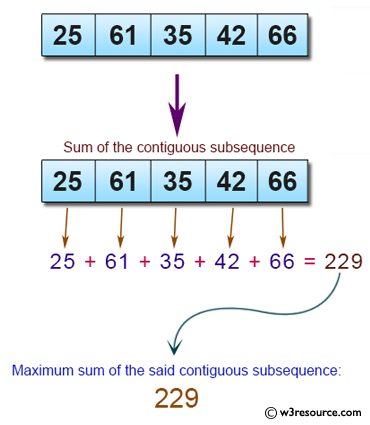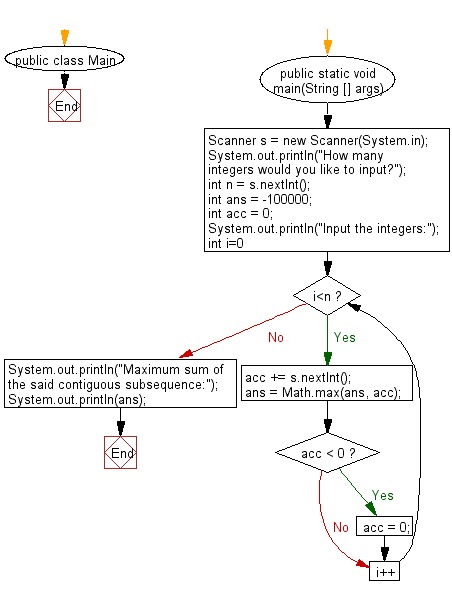Java: Find the maximum sum of a contiguous subsequence from a given sequence of numbers
Maximum Sum of Contiguous Subsequence
Write a Java program to find the maximum sum of a contiguous subsequence from a given sequence of numbers a1, a2, a3, ... an. A subsequence of one element is also a continuous subsequence.
Input:
You can assume that 1 ≤ n ≤ 5000 and -100000 ≤ ai ≤ 100000.
Input numbers are separated by a space.
Input 0 to exit.
Visual Presentation:

Sample Solution:
Java Code:
// Importing necessary Java utilities for input
import java.util.*;
// Main class named "Main"
public class Main {
// Main method to execute the program
public static void main(String [] args) {
// Creating a Scanner object for user input
Scanner s = new Scanner(System.in);
// Prompting the user to specify the number of integers to input
System.out.println("How many integers would you like to input?");
int n = s.nextInt();
// Initializing variables for the maximum sum and the current accumulation
int ans = -100000;
int acc = 0;
// Prompting the user to input the integers
System.out.println("Input the integers:");
// Looping through each input integer to find the maximum contiguous subsequence sum
for (int i = 0; i < n; i++) {
// Accumulating the current integer
acc += s.nextInt();
// Updating the maximum sum using Math.max function
ans = Math.max(ans, acc);
// Resetting the accumulation to 0 if it becomes negative
if (acc < 0) acc = 0;
}
// Outputting the maximum sum of the contiguous subsequence
System.out.println("Maximum sum of the said contiguous subsequence:");
System.out.println(ans);
}
}
Sample Output:
How many integers would you like to input? 5 Input the integers: 25 61 35 42 66 Maximum sum of the said contiguous subsequence: 229
Flowchart:

For more Practice: Solve these Related Problems:
- Write a Java program to find the minimum sum of a contiguous subsequence in a given array.
- Write a Java program to compute the maximum product of a contiguous subsequence in an array.
- Write a Java program to determine the maximum sum of a contiguous subsequence using a divide and conquer approach.
- Write a Java program to find the maximum sum of a contiguous subsequence whose total is an even number.
Go to:
PREV : Test If Two Lines Are Parallel.
NEXT : Test Relationship Between Two Circles.
Java Code Editor:
Contribute your code and comments through Disqus.
What is the difficulty level of this exercise?
Test your Programming skills with w3resource's quiz.
